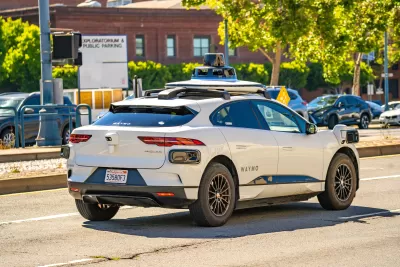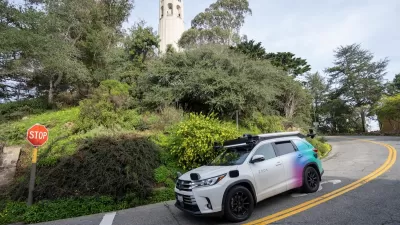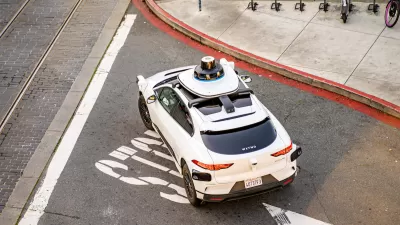Local officials say autonomous cars are not yet safe enough to be permanently deployed across the entire city.

As autonomous taxi companies push for deployment of their self-driving fleets in U.S. cities, city officials and transportation agencies in San Francisco are asking the state to delay the expansion of these services, citing safety and congestion concerns. As Jared Brey explains in Governing, “The stakes are high for all of San Francisco’s street users, and especially for public transit, says Jeffrey Tumlin, director of transportation for the SFMTA.”
“In May, the California Public Utilities Commission issued draft resolutions that would allow Waymo and Cruise, both companies offering self-driving taxi services, to ‘offer passenger service in [their] autonomous vehicles without a safety driver present throughout the city of San Francisco, at all hours of day or night.’” Since then, the vehicles have blocked traffic, stopped dangerously in the middle of the street, driven in transit-only lanes, interfered with emergency response situations, and, in one case, killed a dog.
Public transit officials worry autonomous cars will further disrupt traffic and transit service as transit struggles to recover its ridership and are calling for more data on their safety before they are deployed full-time. The ride-hailing and shared mobility companies that came before autonomous car operators often had combative relationships with cities and regulatory agencies.According to research engineer Tejas Santanam, “Autonomous-vehicle services should take a different tack … working with public agencies to address their needs instead of treating them as obstacles.”
FULL STORY: Why San Francisco Transit Wants a Slower Rollout of Driverless Taxis

Study: Maui’s Plan to Convert Vacation Rentals to Long-Term Housing Could Cause Nearly $1 Billion Economic Loss
The plan would reduce visitor accommodation by 25,% resulting in 1,900 jobs lost.

North Texas Transit Leaders Tout Benefits of TOD for Growing Region
At a summit focused on transit-oriented development, policymakers discussed how North Texas’ expanded light rail system can serve as a tool for economic growth.

Using Old Oil and Gas Wells for Green Energy Storage
Penn State researchers have found that repurposing abandoned oil and gas wells for geothermal-assisted compressed-air energy storage can boost efficiency, reduce environmental risks, and support clean energy and job transitions.

Private Donations Propel Early Restoration of Palisades Playground
Los Angeles has secured over $1.3 million in private funding to restore the Pacific Palisades playground months ahead of schedule, creating a modern, accessible space that supports community healing after recent wildfires.

From Blight to Benefit: Early Results From California’s Equitable Cleanup Program
The Equitable Community Revitalization Grant (ECRG) program is reshaping brownfield redevelopment by prioritizing projects in low-income and environmental justice communities, emphasizing equity, transparency, and community benefits.

Planting Relief: Tackling Las Vegas Heat One Tree at a Time
Nevada Plants, a Las Vegas-based nonprofit, is combating the city’s extreme urban heat by giving away trees to residents in underserved neighborhoods, promoting shade, sustainability, and community health.
Urban Design for Planners 1: Software Tools
This six-course series explores essential urban design concepts using open source software and equips planners with the tools they need to participate fully in the urban design process.
Planning for Universal Design
Learn the tools for implementing Universal Design in planning regulations.
Ascent Environmental
Borough of Carlisle
Institute for Housing and Urban Development Studies (IHS)
City of Grandview
Harvard GSD Executive Education
Toledo-Lucas County Plan Commissions
Salt Lake City
NYU Wagner Graduate School of Public Service





























